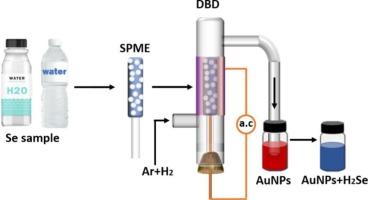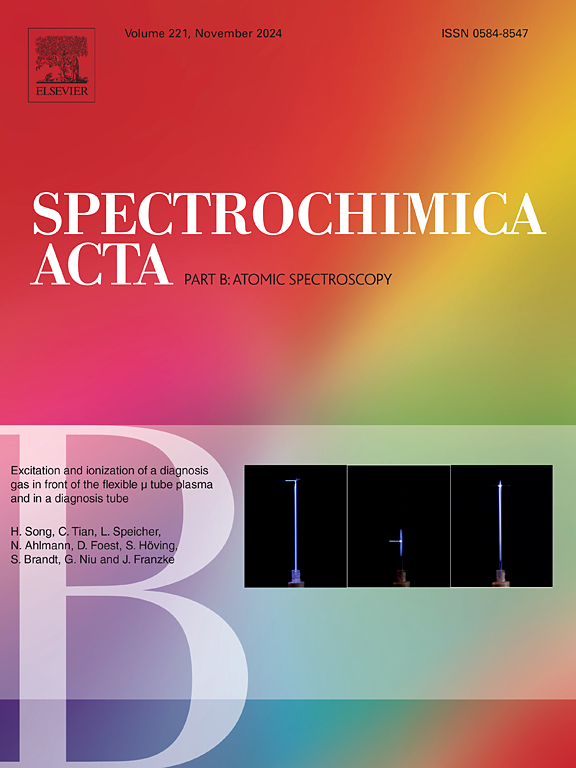基于金纳米粒子的固相微萃取介质阻挡放电蒸汽生成比色法分析饮用水中无机硒形态
IF 3.8
2区 化学
Q1 SPECTROSCOPY
引用次数: 0
摘要
建立了饮用水中无机硒(IV)和硒(VI)形态分析的灵敏比色法。本实验采用固相微萃取法,以纳米tio2为吸附剂,在溶液pH值为4 ~ 7的水中选择性富集硒(IV)。然后,采用介质阻挡放电诱导生蒸气的方法,将Se(IV)吸附在纳米tio2上,生成挥发性的H2Se蒸气。最后,利用金纳米粒子(AuNPs)在引入H2Se蒸汽时诱导颜色变化以测定Se(IV)。采用预还原法和减法测定Se(VI)浓度。该方法可同时实现水样中硒(IV)和硒(VI)的富集和形态分析。对影响吸附、蒸汽产生和颜色变化的实验参数进行了更详细的评估。在最佳条件下,在浓度为50 μg L−1时,硒(IV)的相对标准偏差为1.1%;在50 mL样品体积下,硒(IV)的检出限为0.31 μg L−1;在100 mL样品体积下,硒(IV)的检出限为0.16 μg L−1。与产生氢化物的AuNPs比色法和产生光化学蒸汽的AuNPs比色法相比,该方法具有较低的硒检出限和较强的抗干扰性。该方法具有以上优点,适用于纯净水、富硒天然矿泉水等饮用水样品中Se(IV)、Se(VI)的准确测定。本文章由计算机程序翻译,如有差异,请以英文原文为准。

Gold nanoparticle-based colorimetric assay for inorganic selenium speciation analysis in drinking water by solid-phase microextraction mediated dielectric barrier discharge vapor generation
A sensitive colorimetric assay for the speciation analysis of inorganic Se(IV) and Se(VI) in drinking water samples was proposed in this work. In this assay, solid-phase microextraction with nano-TiO2 as adsorbent was employed for the selective enrichment of Se(IV) in water with solution pH values ranging from 4 to 7. Then, dielectric barrier discharge induced vapor generation was used to generate volatile H2Se vapor from Se(IV) adsorbed on nano-TiO2. Finally, gold nanoparticles (AuNPs) were utilized to induce a color change upon the introduction of H2Se vapor for Se(IV) determination. The Se(VI) concentration was determined by pre-reduction and subtraction. With this assay, the enrichment and speciation analysis of Se(IV) and Se(VI) in water samples could be realized simultaneously. The experimental parameters that influence the adsorption, vapor generation, and color change were evaluated in greater detail. Under optimal conditions, the relative standard deviation for Se(IV) was 1.1 % at a concentration of 50 μg L−1 and the detection limit for Se(IV) was 0.31 μg L−1 with 50 mL sample volume and 0.16 μg L−1 with 100 mL sample volume by UV–Vis detection. Compared with the AuNPs colorimetric assays with hydride generation and photochemical vapor generation, this assay exhibits a lower detection limit of Se and a greater resistance to interference. With these advantages, this method was proved to be applicable for accurate determination of Se(IV) and Se(VI) in drinking water samples such as purified water samples and Se-enriched natural mineral water samples.
求助全文
通过发布文献求助,成功后即可免费获取论文全文。
去求助
来源期刊
CiteScore
6.10
自引率
12.10%
发文量
173
审稿时长
81 days
期刊介绍:
Spectrochimica Acta Part B: Atomic Spectroscopy, is intended for the rapid publication of both original work and reviews in the following fields:
Atomic Emission (AES), Atomic Absorption (AAS) and Atomic Fluorescence (AFS) spectroscopy;
Mass Spectrometry (MS) for inorganic analysis covering Spark Source (SS-MS), Inductively Coupled Plasma (ICP-MS), Glow Discharge (GD-MS), and Secondary Ion Mass Spectrometry (SIMS).
Laser induced atomic spectroscopy for inorganic analysis, including non-linear optical laser spectroscopy, covering Laser Enhanced Ionization (LEI), Laser Induced Fluorescence (LIF), Resonance Ionization Spectroscopy (RIS) and Resonance Ionization Mass Spectrometry (RIMS); Laser Induced Breakdown Spectroscopy (LIBS); Cavity Ringdown Spectroscopy (CRDS), Laser Ablation Inductively Coupled Plasma Atomic Emission Spectroscopy (LA-ICP-AES) and Laser Ablation Inductively Coupled Plasma Mass Spectrometry (LA-ICP-MS).
X-ray spectrometry, X-ray Optics and Microanalysis, including X-ray fluorescence spectrometry (XRF) and related techniques, in particular Total-reflection X-ray Fluorescence Spectrometry (TXRF), and Synchrotron Radiation-excited Total reflection XRF (SR-TXRF).
Manuscripts dealing with (i) fundamentals, (ii) methodology development, (iii)instrumentation, and (iv) applications, can be submitted for publication.

 求助内容:
求助内容: 应助结果提醒方式:
应助结果提醒方式:


